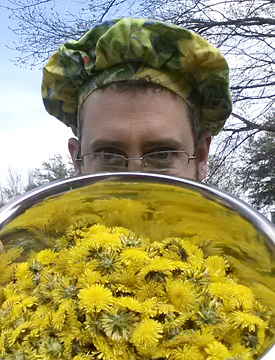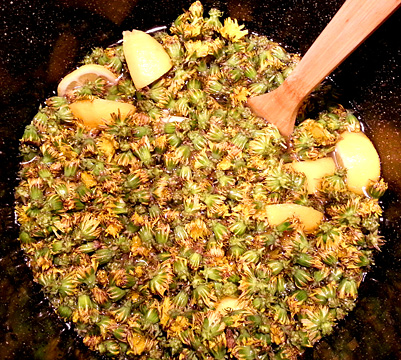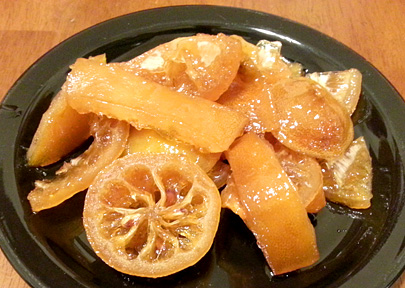 Either you love dandelions, or you hate them. If you hate them, it’s probably because you spend so much time trying to rid your lawn of them. If you love them, it’s because the big, soft, bright yellow blossoms and supremely blow-able puff balls bring you back to childhood. Or perhaps you’re one of the few who know exactly how edible the dandelion is. All parts of this miraculous weed are delicious, from the roots (which can be roasted and ground into chicory…a popular additive or substitute for coffee, particularly in Louisiana), to the leaves (which are crisp and tangy with a slight bitterness, like arugula, provided you pick them before the plant blossoms), to the yellow petals which are fragrant, tangy, and lightly sweet. (Avoid the green sepal that holds the petals together unless you are cooking the blossoms…it can be a bit bitter for raw eating.) When you harvest the blossoms, use or refrigerate them quickly. They will start to close up. They can still be used for this recipe even if they are closed, but if you want them open to use the petals, you need to use them quickly. As a note of curiosity, dandelion blossoms open every morning for 3 days, closing up around noontime. On the 4th day, they open as the puffballs that kids love to play with.
Either you love dandelions, or you hate them. If you hate them, it’s probably because you spend so much time trying to rid your lawn of them. If you love them, it’s because the big, soft, bright yellow blossoms and supremely blow-able puff balls bring you back to childhood. Or perhaps you’re one of the few who know exactly how edible the dandelion is. All parts of this miraculous weed are delicious, from the roots (which can be roasted and ground into chicory…a popular additive or substitute for coffee, particularly in Louisiana), to the leaves (which are crisp and tangy with a slight bitterness, like arugula, provided you pick them before the plant blossoms), to the yellow petals which are fragrant, tangy, and lightly sweet. (Avoid the green sepal that holds the petals together unless you are cooking the blossoms…it can be a bit bitter for raw eating.) When you harvest the blossoms, use or refrigerate them quickly. They will start to close up. They can still be used for this recipe even if they are closed, but if you want them open to use the petals, you need to use them quickly. As a note of curiosity, dandelion blossoms open every morning for 3 days, closing up around noontime. On the 4th day, they open as the puffballs that kids love to play with.
When I posted on Facebook about the edibility of dandelions, I got some amazing responses, but the one that truly stood out was from my fan Katja Turk, who shared with me a treasured family recipe from the days when her grandmothers were living in the communist era in Slovenia:
“I’m sending you a recipe for a dandelion honey (this is an oooold recipe the way that our grandmothers used to make it) – back in the days people couldn’t afford to buy honey and even if they owe bees for it, they usually only used honey for selling and not for eating. So this was some sort of cheeper way to make honey and they also used it as medicine when they had sore throat”
As soon as I read the recipe, I dashed out into my neighbor’s yard, which is overrun with dandelions, and picked for about 15 minutes until I had enough to make the recipe. And the results were startlingly delicious. I actually made a mistake the first time I made this recipe, but it resulted in a fabulous bonus…dandelion-candied lemon. So here’s how I made it the first time, which is pretty much exactly the same results I got from making it the second time according to the instruction Katja sent me…
In a big pot, combine:
about 300 dandelion blossoms (I used about 600 for extra flavor, and you don’t have to remove the green part)
3 whole lemons, cut into 1″ round slices
2 liters of water (that’s about 8 1/2 cups)
6 1/2 pounds of sugar (about 12 1/2 cups)
 Bring everything to a rapid boil, then reduce the heat to maintain a rolling boil. Boil for 2-3 hours until the appearance of the boil changes from looking more like water boiling to very glassy, sticky bubbles and the color of the liquid has turned deep golden. Then VERY CAREFULLY pour the liquid through a large strainer or colander into a heat-proof bowl or pitcher. (Hot sugar syrup sticks like crazy and is much hotter than boiling water so be extremely cautious.) Using tongs, carefully remove the pieces of lemon from the dandelions and set them on a plate to cool. These are now candied lemons, with an incredible flavor and texture. Chop them up and serve them for breakfast…they are delicious on toast or biscuits or pancakes, or use them on top of ice cream or inside fruit pies. Or dip them in chocolate. They are DIVINE!
Bring everything to a rapid boil, then reduce the heat to maintain a rolling boil. Boil for 2-3 hours until the appearance of the boil changes from looking more like water boiling to very glassy, sticky bubbles and the color of the liquid has turned deep golden. Then VERY CAREFULLY pour the liquid through a large strainer or colander into a heat-proof bowl or pitcher. (Hot sugar syrup sticks like crazy and is much hotter than boiling water so be extremely cautious.) Using tongs, carefully remove the pieces of lemon from the dandelions and set them on a plate to cool. These are now candied lemons, with an incredible flavor and texture. Chop them up and serve them for breakfast…they are delicious on toast or biscuits or pancakes, or use them on top of ice cream or inside fruit pies. Or dip them in chocolate. They are DIVINE!
Let the syrup cool completely, and now you’ve got about 3 quarts of an incredibly delicious syrup that is wonderful on pancakes or waffles. (We served them over an acorn buckwheat waffle for dessert at FRANK and people lost their minds.) This amount of syrup is enough to last you all year until the next dandelion harvest, or double the recipe and share with friends. They will demand the recipe.
I wanted to include some of the remarks Katja made about the recipe:
“This honey is not like the honey you’re used of. It’s not that thick, but if you want, you can use more sugar, cook it longer or use the gelatin for jam or marmelade. So this honey (before you add sugar, gelatin etc.) may not be thick enough to use it on bread, but it’s great to sweeten desserts, tea or as a syrup and just mix it with water.”
Many thanks to you, Katja, for sharing this time-honored recipe from your family. I felt honored making it and sharing it with my own family and with guests at my restaurant. To me, all recipes with such a story taste infinitely better because the legacy of those who prepared it for generations past can be TASTED in the final product. This recipe will become a tradition in my family from now on!



Leave a Reply
You must be logged in to post a comment.